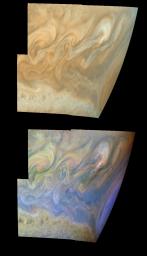Turbulent Region Near Jupiter’s Great Red Spot
Caption:
True and false color mosaics of the turbulent region west of Jupiter's Great Red Spot. The Great Red Spot is on the planetary limb on the right hand side of each mosaic. The region west (left) of the Great Red Spot is characterized by large, turbulent structures that rapidly change in appearance. The turbulence results from the collision of a westward jet that is deflected northward by the Great Red Spot into a higher latitude eastward jet. The large eddies nearest to the Great Red Spot are bright, suggesting that convection and cloud formation are active there.
The top mosaic combines the violet (410 nanometers) and near infrared continuum (756 nanometers) filter images to create a mosaic similar to how Jupiter would appear to human eyes. Differences in coloration are due to the composition and abundance of trace chemicals in Jupiter's atmosphere. The lower mosaic uses the Galileo imaging camera's three near-infrared (invisible) wavelengths (756 nanometers, 727 nanometers, and 889 nanometers displayed in red, green, and blue) to show variations in cloud height and thickness. Light blue clouds are high and thin, reddish clouds are deep, and white clouds are high and thick. Purple most likely represents a high haze overlying a clear deep atmosphere. Galileo is the first spacecraft to distinguish cloud layers on Jupiter.
The mosaic is centered at 16.5 degrees south planetocentric latitude and 85 degrees west longitude. The north-south dimension of the Great Red Spot is approximately 11,000 kilometers. The smallest resolved features are tens of kilometers in size. North is at the top of the picture. The images used were taken on June 26, 1997 at a range of 1.2 million kilometers (1.05 million miles) by the Solid State Imaging (SSI) system on NASA's Galileo spacecraft.
Background Info:
The Jet Propulsion Laboratory, Pasadena, CA manages the Galileo mission for NASA's Office of Space Science, Washington, DC. JPL is an operating division of California Institute of Technology (Caltech).
This image and other images and data received from Galileo are posted on the World Wide Web, on the Galileo mission home page at URL http://galileo.jpl.nasa.gov.
Cataloging Keywords:
| Name |
Value |
Additional Values |
| Target |
Jupiter |
|
| System |
Jupiter |
|
| Target Type |
Planet |
|
| Mission |
Galileo |
|
| Instrument Host |
Galileo Orbiter |
|
| Host Type |
Orbiter |
|
| Instrument |
Solid-State Imaging (SSI) |
|
| Detector |
|
|
| Extra Keywords |
Atmosphere, Collision, Color, Haze, Infrared, Storm |
| Acquisition Date |
|
| Release Date |
1997-12-04 |
| Date in Caption |
1997-06-26 |
|
| Image Credit |
NASA/JPL-Caltech |
| Source |
photojournal.jpl.nasa.gov/catalog/PIA01093 |
| Identifier |
PIA01093 |

 Planetary Data System
Planetary Data System
